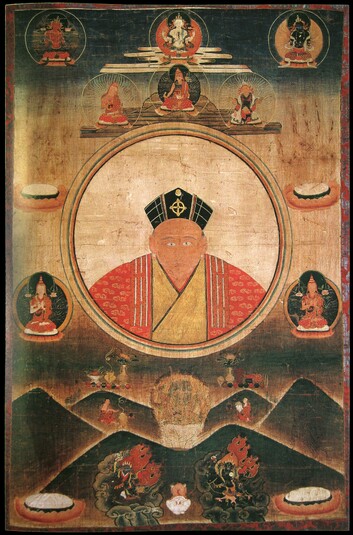
Item: Teacher (Lama) - Karmapa 3, Rangjung Dorje
| Origin Location | Tibet |
|---|---|
| Date Range | 1800 - 1899 |
| Lineages | Kagyu, Karma (Kagyu) and Buddhist |
| Material | Ground Mineral Pigment on Cotton |
| Collection | Hahn Cultural Foundation |
| Painting School | Palpung / Situ |
Rangjung Dorje, 3rd Karmapa, appearing in front of a full moon along with the outlines of the two hands and two feet of a later Karmapa.
At the top center is Avalokiteshvara with Manjushri on the left and Vajrapani on the right side - the Three Lords of the World. Directly below, in the middle is Padmasambhava with Vairochana and King Trisong Detsen.
Rangjung Dorje is only depicted with the head and shoulders against a white full moon further encircled by rainbow light, based on the vision of the Mongolian chieftain Dragpa Sengge in 1339, shortly after the passing of Karmapa.
At the upper right and left sides, hardly legible, are two hand prints. At the bottom right and left are footprints which are likely to be those of the current Karmapa at the time. The over-all look of the painting is Eastern Tibetan, 19th or early 20th century, and very much in a Palpung Monastery style based on the new painting aesthetics of Siti Panchen Pema Jungne in the 18th century.
The hand and foot prints are personally applied and it is most likely that the face of the Karmapa is not trying to replicate that of the 3rd Karmapa (1284-1339 who passed away at the age of 55 years, but rather that of a known Karmapa who is the same as the provider of the hand and foot prints.
The two Karmapa possibilities for the prints are the 14th Gyalwa Karmapa, Tegchog Dorje (1799-1869) who passed away at 70 years of age and the 15th Gyalwa Karmapa, Kakyab Dorje (1870/71-1921/22) who passed at the age of 51. The Karmapa figure in the composition is elderly in appearance with whitish hair, lines on the face, and an enlarged nose. Based on the characteristics of the visage of the figure it most likely would seem to be the 14th Karmapa, Tegchog Dorje who lived to the age of 70.
Another interpretation could be that the prints and portrait are of the 15th Karmapa who passed away at 51 years in 1921 or 1922 which would make the painting a lot more recent. The portrait does seem a little old for a person of 51 but possibly fits better chronologically if the two side figures are identified as Jamgon Kongtrul Lodro Taye (1813-1899 [TBRC P264]) and Ju Mipham Jamyang Gyatso (1846–1912).
The prints are typically made from saffron water and have faded with time. It is also possible that the Bernagchen Mahakala (at the lower center) that has also suffered from fading, was colour filled with very light pigments, water, and the spittle or nasal mucous of the 14th Karmapa. This would also account for the fading.
The black hat is somewhat unusual with the emblem of a four spoked wheel rather than with eight spokes. The wheel is not typical for any of the black hats which usually have a diamond shape for the early hats and a double vajra for the later hats post 15th century. The hat depicted of course is intended to predate the more elaborate black hat received as gift by the 5th Karmapa from the Yongle Emperor of China in the early 15th century.
It is interesting to note that there appears to be two earrings adorning the pierced earlobes of Karmapa. On a closer inspection the objects would seem to be rolled paper in the manner of heart instruction teachings concealed in plain sight.
At the middle of the composition, below the handprints are two monastic figures. The teacher at the left appears to be Jamgon Kongtrul Lodro Taye identified by the attributes of a sword, book and a svastika symbol. The figure on the right side has the two hands in the teaching gesture along with grasping the stems of two flower blossoms supporting a sword and book. The attributes of a sword and book are popular and widespread in use. However, taking into consideration the relationship to Jamgon Kongtrul, the bottle-top pandita hat, along with the hand gesture and attributes, then it is possible that the figure is Ju Mipham Jamyang Gyatso.
At the bottom center is Bernagchen Mahakala with Damchen Garwa Nagpo and Shri Devi Rangjung Gyalmo below.
Jeff Watt 1-2022
Teacher: Rangjung Dorje, 3rd Karmapa (Face on the Moon)
Teacher: Karmapa 3rd, Rangjung Dorje
Incarnation Lineage: Karmapa (Handprints & Footprints)
Incarnation Lineage: Gyalwa Karmapa Main Page
Collection of Hahn Cultural Foundation (Vol. V)
